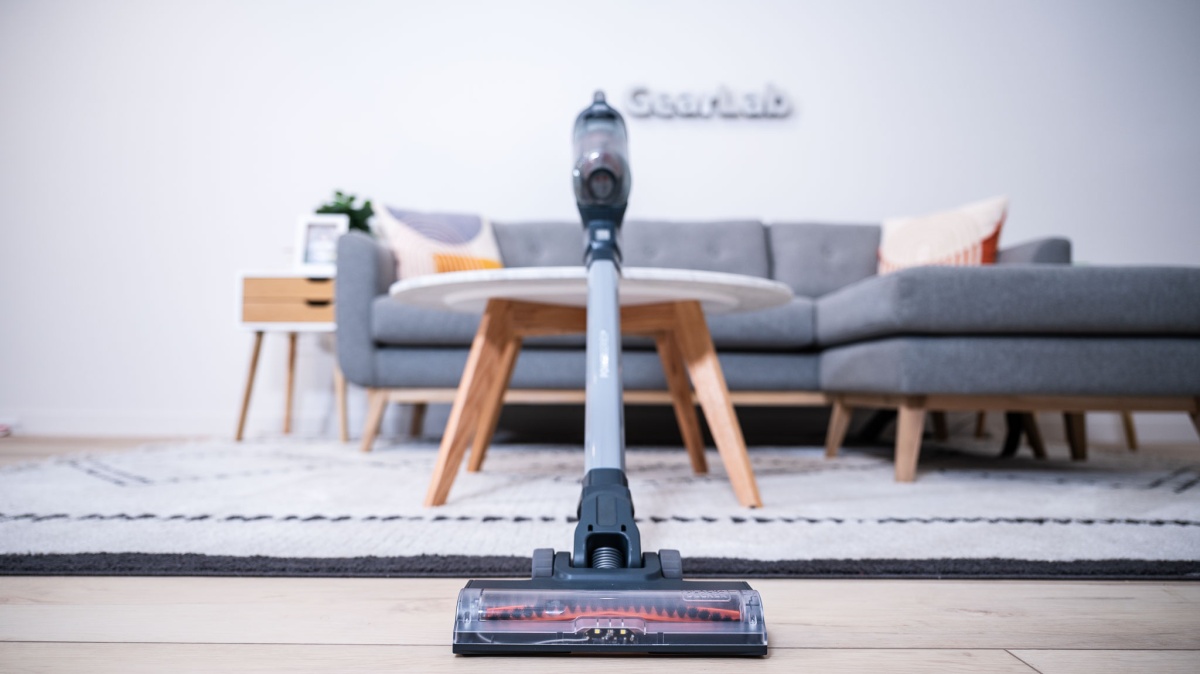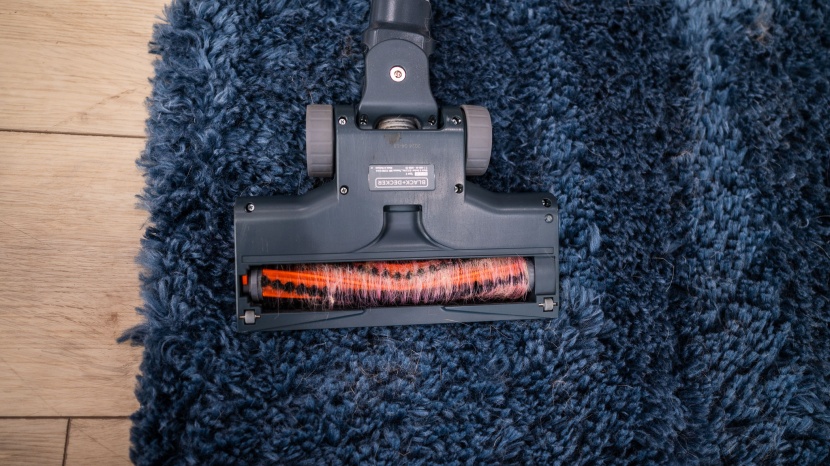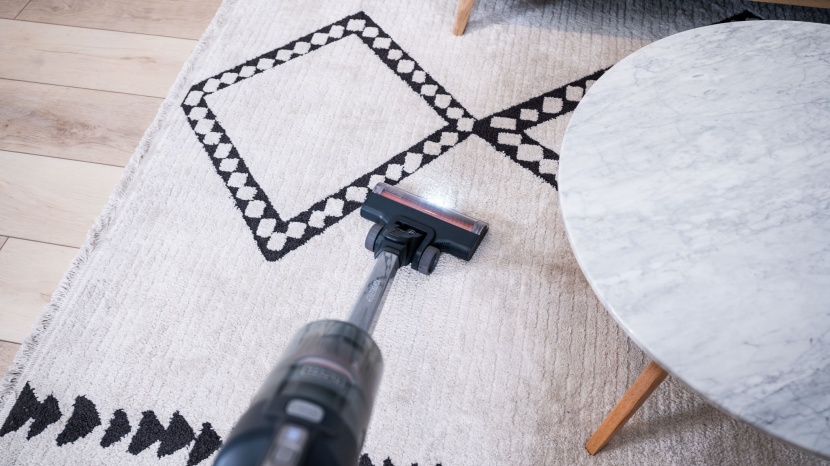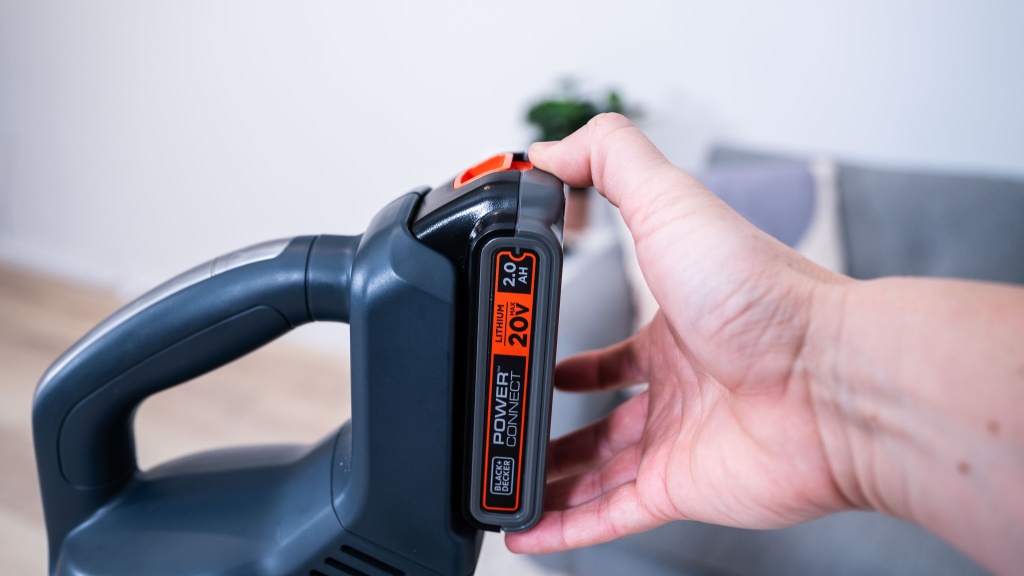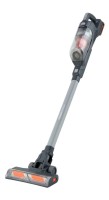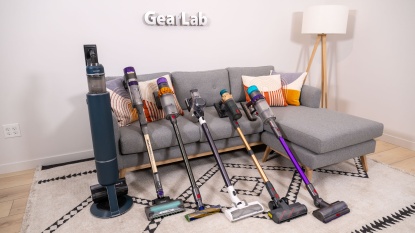
Our Verdict
Our Analysis and Test Results
This vacuum comes with a wall mount, but it also stands up by itself if you don't have any wall space to give up.
Carpet Performance
This model features relatively low head gates, making it difficult for debris to pass underneath where the brush roll and suction can effectively collect it. As a result, it often pushes larger debris, like Cheerios and occasionally even rice, instead of picking it up. However, it performed noticeably better with smaller debris, such as sand, particularly on low-pile carpets.
On high-pile carpets, the snowplow theme is even more pronounced as the head sinks into the plush carpet, allowing the Cheerios and rice to float high above the bottom of the cleaner head. This model managed to suck up only 24% of all debris, which was far below our pickup rate average in our high pile carpet test.
Meanwhile, we observed another issue with this vacuum on shaggy carpet. The suction just wasn't powerful enough to suck up deeply embedded sand.
Hardwood Performance
Overall, this product was able to suck up just 62% of the material in our hardwood floor test. This amount of debris in our timed test proved too much to handle for this little vacuum.
As we tackled the mess, we could see the cleaner head create a disappointing spray action that sometimes blew the rice away, making it harder to collect debris.
This vacuum picked up most of the coffee we spilled near the wall head-on, but left quite a bit behind when running parallel to the wall.
There is no way around this: Performance on hardwood floors is mediocre for this model. We believe the cleaner head seal on hardwood floors is relatively weak, leading to inconsistent results that left debris in little island patches. While it can handle small messes, you'll need to use more passes over debris to collect it.
Pet Hair
Interestingly, pet hair seemed to slip under the cleaner head much better than larger debris, leading to an above-average pet hair rating on low pile carpet.
Of course, like most vacuums we tested, long hair quickly became hopelessly wrapped on the brush roll.
Filtration
To put this metric in perspective, vacuums that do well in this test have fine particulate measurement spikes that are less than 75. This vacuum released 1,542 small particles, which Dylos ranks as poor air quality.
| Black+Decker Powerseries+ 20V | |
|---|---|
| Small Particle Count | 1542 |
| HEPA Filter | ✖ |
| Dylos Air Quality Designation | Poor |
This high count implies that not only did the vacuum allow flour and dust to escape its dustbin, but it also tended to blow some fine particles into the air rather than sucking them up. Disturbing flour before sucking it up also matches our experience on hard floors where this vacuum seemed to spray rice.
If allergens and biological contaminants are a problem in your household, we don't recommend this vacuum.
Ease of Use
Maneuverability is the shining star of this vacuum, thanks to its relatively low handheld weight of 3.7 pounds and lightweight cleaning head.
During our tests, we navigated a typical living room with chair legs and uneven terrain, featuring bamboo mats, and had no problem with either. It can easily glide across surfaces, making multiple passes a non-issue.
For maintaining the filter, it is easy to remove and rinse, but users must remove the dustbin to empty it, which tends to drop some fine debris.
The vacuum comes with a crevice tool that can be mounted to the base, clicked into place, and ready to use in no time. We long for more attachments, as this can extend the tool into more spaces in the house and car. This is usually one of the compromises with budget models.
Battery
Regarding battery life, the Black+Decker is sufficient for small, quick tasks. On its lowest setting, it ran for 26 minutes, which is below average, providing only enough time to tackle a few rooms at most.
When cranking it up to its highest setting, it managed 18 minutes of runtime, which is above average. When we see a long, high setting runtime that's well over half of the lowest setting, we correlate that to a relatively low-power boost relative to the lowest setting. Either way, in our experience, we believe most people with typically dirty floors will have a hard time completing all rooms in an average 3-bedroom, 2-bath home on just one battery charge.
Should You Buy the Black+Decker Powerseries+ 20V?
You'll need to assess the level of mess that needs cleaning in your home. The Powerseries+ can manage basic tasks, and it's very easy to operate and maneuver, which is important for a household cleaning device. Plus, it's affordable. The convenience factor is somewhat overshadowed by its low suction power and filtration, so we can't fully recommend this model unless you're on a tight budget and are willing to work with its compromises.
What Other Stick Vacuum Should You Consider?
The Levoit LVAC 200 and Smoture VAC01 are an absolute bargain for the performance they produce, which surpasses that of the Black+Decker Powerseries+ 20V by far. It excels in nearly every aspect except pet hair and still manages to remain within budget territory. Similarly, the Shark Pet Plus offers impressive performance at a reasonable cost, particularly excelling in carpet cleaning.
| Awards | |
|---|---|
| Price | $150 List Check Price at Amazon |
Overall Score  |
|
| Star Rating | |
| Bottom Line | This vacuum is affordable and will get the job done, but the overall suction power and cleaning prowess work better on hard floors than carpet |
| Pros | Great maneuverability, light, inexpensive, great for pet fur |
| Cons | Low suction power, messy to empty bin, poor filtration |
| Rating Categories | Black+Decker Powerse... |
| Carpet Performance (30%) | |
| Hardwood Performance (25%) | |
| Pet Hair (20%) | |
| Ease of Use (10%) | |
| Filtration (10%) | |
| Battery (5%) | |
| Specifications | Black+Decker Powerse... |
| Max Mode Runtime | 18 min |
| Low Mode Runtime | 26 min |
| Storage | Wall mount |
| Handheld Weight | 3.5 lbs |
| Suction | 50 Pa |
| Low Pile Cleaned | 73% |
| High Pile Cleaned | 24% |
| Hardwood Cleaned | 62% |
| Pet Hair Cleaned | 59% |
| Charge Time | 4.7 hrs |
| Dustbin Capacity | 0.2 L |
| Noise Level | 78 dBA |
| Trigger | No |
| Variable Suction Control | Yes, automatic |
| Model Number | BHFEA18D1 |


